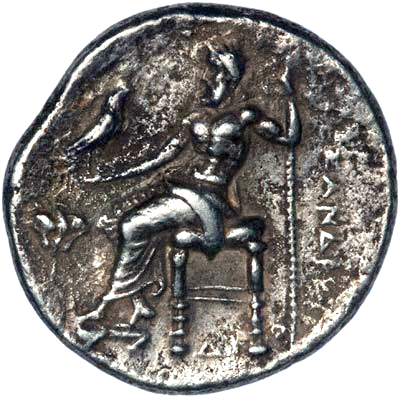|
Ancient Greece
|

 |
|
|

|
|
Obverse of Alexander the Great Tetradrachm
|
|
Countries
|

|
|
Reverse of Alexander the Great Tetradrachm
|
Ancient Greece
The earliest European coins were first minted in Ancient Greece in the Seventh Century B.C. following an innovation in the Ionian city of Lydia (now a part of Western Turkey). By the 5th Century BC, coins minted to the Attic Standard (approximately 4.3g to the drachm) were becoming the pre-eminent medium of exchange in the Greek World, thanks to the dominance of Athens in seaborne trade. The large-sized tetradrachm of Athens with the goddess Athena on the obverse owl of Athens on the reverse is a classic of ancient numismatics, which still influences greek coinage to this day (see our modern page on Greece to see why). Most of the Greek City States of this period minted their own coins, with designs representing their own particular cities. The City of Syracuse is usually represented by a Quadriga (a four-horsed chariot), and Appolonia Pontika the Gorgon Medusa and/or a crayfish, and so on. Sparta was a notable exception. Sparta refused to mint coins because the believed it encouraged the accumalation of wealth, and therefore the purchase of luxury and comfort, which would then lead to Sparta's citizens becoming decadent and soft!
By the time of Alexander the Great, huge quantities of silver from Alexander's conquests were being minted into coins, and the sheer size of Alexander's Empire had spread hellenic culture and influence throughout most of the known world. Greek drachms, tetradrachms, didrachms, bronze obols, often struck in Alexander's name (even long after his death) were used as currency from Macedonia, Greece, Asia Minor, Syria, The Holy Land, Egypt and as far east as India! As well as those struck posthumously in Alexander's name, coins were struck in the name of rulers of the various successor states and empires that sprang up following his death in 323 B.C.
Even after the gradual conquest of most of the Hellenic world by the Romans, 'Greek' coinage continued to be used in the Hellenic parts of the Empire, although they became gradually more debased along with the rest of the coinage in the Roman Empire throughout the crisis years of 235-285 A.D. until by the end of the third century, the once mighty silver Tetradrachm had been reduced to a tiny billon (less than 50% silver alloy) coin. By 294 A.D. The Emperor Diocletian (284-305) began an Empire-wide currency reform to replace the old-debased currencies, and thus, the old coinage system of 'Ancient Greece' came to an end, approximately 900 years after it had first begun.
Price & Availability
Postage & Packing:
UK: At buyer's Risk £3.50 or
Fully Insured £9 (Usually by Royal Mail Special Delivery)
USA: Airmail at buyer's risk $10 or
Fully Insured $20
For further details, please see our Postage & Packing page.
Order Form - UK
Order Form - USA
Order Form - EU
Order Form - Rest of World
Coins Wanted
We make an active market in almost all world coins, gold or otherwise, including Greek coins. If you have any of these coins to sell, please contact us, or post them to us for appraisal and offer.
|
...at the Official Issue Prices
|

